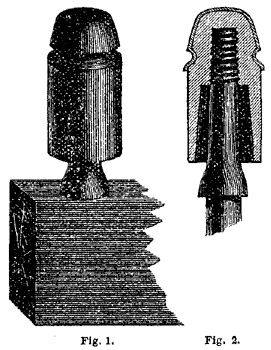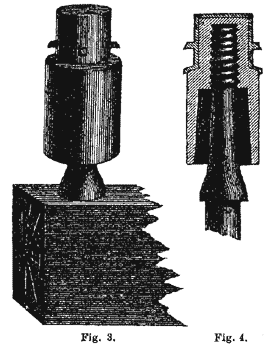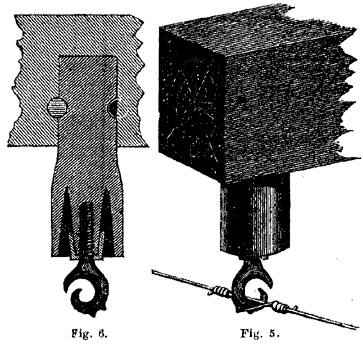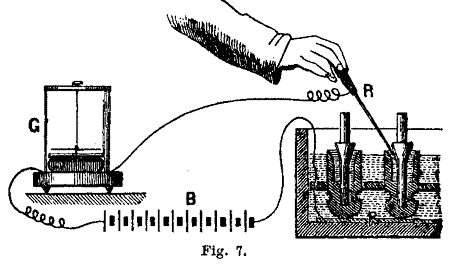[Trade Journal]
Publication: The Telegrapher
New York, NY, United States
vol. 11, no. 450, p. 49-50, col. 1-3
The Kenosha Carbon Insulator.
BY F. L. POPE.
IF the history of all the experiments which have been made in telegraphic insulation in this country and in Europe could be written by a competent pen, it would form one of the most instructive, not to say amusing works that could possibly be imagined.
Mr. Shaffner, in his Telegraph Manual, has given us some glimpses of it, it is true, but as a whole, the subject still awaits its chronicler. The cloth and gum-lac insulation of the original Baltimore and Washington line, in 1844, was almost immediately superseded by a glass knob set upon a wooden pin: This proved to be a partial success, or, at least an essential improvement, and at once a host of inventive telegraphers set their minds at work to improve its form and to devise various shields and protections to prevent its fracture. A mere list of the different plan; devised and adopted from that day to this would alone till a column. But the end of the first quarter of a century of invention and costly experience found at least 95 per cent. of the telegraph wire mileage of the United States still strung upon the glass insulator, and subject to all the grave inconveniences with which the use of that material has rendered telegraphers but too familiar. It is true that other and tar superior methods of insulation had been devised, but like most other good things, they entailed a considerable increase in first cost. This fact operated as a bar to their rapid and general introduction. Thus the reign of the glass insulator remained for the most part unbroken-which, by the way, is more than could safely be affirmed as a rule of the insulator itself.
The importance of this subject was recognized by the more intelligent telegraphers at a very early day. I have before me a copy of the American Telegraph Magazine, of Dec. 15th, 1852. In an article upon insulation the editor, Mr. Donald Mann, says: "The improvement of telegraphic insulation is the most important matter now to be considered in the building and working of telegraph lines"-a remark which is as true to-day as it was twenty-two years ago. He further goes on to say: "Science has told us, ever since the first mile of telegraph was erected, that we should not rely upon glass as an insulator, and yet we have used it almost universally. Every one has observed that, whenever the weather is wet or foggy, any article of glass is covered with a thin film of water, and, of course, every 'insulator' on a line of telegraph is so covered with moisture. And when we reflect that on a line of telegraph five hundred miles in length there are 15,000 such imperfect insulators to conduct the fluid from the wire; we are at no loss to account for the dissipation of all, or nearly all the galvanism generated by the battery, and the consequent bad working of the line." Finally, after some further discussion of the subject, he closes with the following suggestion: "It is well known that dry wood, as an insulator, is inferior to no other material. Shellac is also as perfect an insulator as we have. Now saturate and cover dry wood with shellac varnish, and we have a cheap and nearly perfect insulator. Moisture does not condense on and cover a varnished surface as it does a glass surface."
In this crude suggestion of Mr. Mann's lay the germ of the invention of the Kenosha Insulator. The original idea was tried and failed. Exposure to the weather soon covered the varnished surface with minute cracks, which retained moisture, or allowed it to penetrate into the pores of the wood. A few years later the invention was again revived, the wood in this instance being coated with coal tar. This proved little, if any, better in practice than the original plan. Five or six years ago a new compound was discovered, which seemed to be admirably adapted to the purpose under consideration. The results of a somewhat extensive practical trial proved so satisfactory that in 1871 a manufacturing company was organized, consisting of several well known telegraph men, prominent among whom was Mr. Z. G. Simmons, of Kenosha, Wis., President of the North Western Telegraph Company. The new company immediately proceeded to establish a manufactory of insulators at Kenosha, and to introduce the new invention into practical use as rapidly as possible. During the first year or two many serious obstacles and drawbacks were encountered, such as seem inseparable from all new enterprises. Not only was the inevitable prejudice against innovations to be overcome, which in the case of insulators is, for obvious reasons, a very serious one, but there were imperfections in the process of manufacture which could only be made known by experience or actual use. In 1872 Mr. C. H. Haskins became connected with the company; his skill and knowledge as an electrician, and practical experience as a telegraph manager, has proved of great value in the development and perfection of the invention and of the processes of manufacture. Mr. Haskins introduced, among other improvements, the system of making a thorough actual test of every insulator before allowing it to leave the factory. In this way the standard of excellence has been gradually raised, and the sale and use of the insulator proportionally extended.
A few months ago the writer, in passing through Kenosha, took occasion to visit the establishment where these insulators are manufactured. A brief description of the insulator itself in its different forms, and of the process of manufacture, will doubtless possess much interest for telegraphers.
 |
Figure 1 represents the original form of the insulator, of which pattern a large number are made. It is shown as fixed upon a pin and inserted in a cross-arm. The same form may be used with a bracket similar to that of a common glass insulator.
 |
Figure 2 is a sectional view, which exhibits the internal arrangement and the mode of construction. It will be observed that in form the insulator is long, and of small diameter. The object of this is to give as great an insulating distance as possible from the supporting pin to the point where the line wire is attached. The small diameter also narrows the conducting surface, and thus adds to the electrical resistance. The upper part of the insulator, including the wire groove, is covered with a cap of sheet zinc, which is put on by machinery by a process which will be explained hereafter, and which preserves the wood from splitting or being injured by the exposure of the end of the grain to the weather. The body of the insulator is of white wood, thoroughly kiln dried, and then coated with the insulating compound, which is composed of tar and charcoal flour, the tar being subjected to a process which gives it a certain degree of elasticity, and prevents it from cracking under the influences of changes of temperature. Brackets, pins and cross-arms are also treated by the same process. The surface of the coating, when finished, is of a glossy black, and highly repellant of moisture. It penetrates some distance into the body of the wood, and adheres to it with the utmost tenacity.
Figures 3 and 4 showed a modified form of the above insulator, in which the zinc cap is replaced by one of cast iron, provided with a projection for holding the tie wire, as shown. The peculiarities of its construction are sufficiently explained by the illustrations.
Figure 5 is a perspective view of the suspension or hook insulator, a form which combines superior insulating qualities with great strength as well as convenience in use. The body of this insulator is of maple, treated by the above described process. The peculiar form of hook used was devised by Mr. Haskins, and possesses many advantages. The objections to the ordinary forms of suspension hooks are well known. The line wire is cramped in placing it in the hook, and its tensile strength is often greatly injured by the operation. The vibration caused by the wind tends to still further injure the wire at the point where it is clamped. In Mr. Haskins' hook the line wire is secured by a tie wire. The arrangement is so clearly shown in figure 5 as scarcely to need description.
 |
Figure 6 is a sectional view of this form of insulator. The projection of wood into which the hook is screwed is surrounded by a deep groove, and is covered with, a malleable iron ferrule. The hook itself being also of malleable iron, the whole arrangement necesssarily [sic] necessarily possesses, great strength. The insulator is inserted into a hole bored in the under side of the arm, and is secured with a pin, in the manner clearly shown in the illustration.
There can be no doubt that, other things being equal, an insulator which holds the wire by suspension is preferable to one which is supported upon a pin above the arm. In a heavy shower the drops of rain falling upon the top of the arm are dashed into a fine spray, which often rebounds to the height of a foot or more, and thus a constant shower of water is thrown into the interior of the insulator, wetting the whole inner surface, and seriously affecting its insulating qualities. Again, it sometimes happens that wet snow will become piled up at the arm, so as to reach the wires, and cause a very serious leakage. The suspension insulator is free from both these objections, while it is not only a stronger but a far neater looking method of supporting the wires.
The process of manufacture in itself presents many interesting features. The factory is situated in the City of Kenosha, directly upon the shore of Lake Michigan, and in immediate proximity to a wharf for the convenience of unloading vessels bringing lumber and other material. The machinery is situated in a large two-story building, adjoining which is another building used as a storehouse and testing room. In the yard are two dipping and two baking houses. The machinery is driven by a steam engine of fifty horse power.
The raw material is received at the factory in the form of white wood and maple planks from the forests of Michigan. The white wood planks are 2-1/2 inches in thickness, and are used for the cap insulators, while the maple, which are used for suspension insulators, are thinner by half an inch. The white wood is cut into sticks 2-1/2 inches square and 5 feet in length by a circular saw; and these are next turned into a cylindrical form by means of a machine resembling a hollow auger, and then cut into blocks about 4-5/8 inches long, each one of which is an insulator in the rough. These blocks are then successively subjected to the operation of three different machines, the first of which shapes the inside of the insulator, including the socket for the pin, by means of a rapidly revolving cutter; the second cuts the screw thread in the socket, and the third shapes the top into a hemispherical form, and cuts the groove for the tie wire.
The sheet zinc, which is used for covering the upper portion of the insulator, is received at the factory in strips about five inches broad. A powerful swaging machine, in the second story of the main building, cuts from a strip, at a single blow, a suitably shaped piece of the metal, and forms it into a cup. Two other machines, by pressing this cup in dies, gives it a form resembling half an egg, and a fourth machine cuts the edge off evenly. Finally, this is firmly: "spun" on to the wooden insulator, which has been prepared in the manner before described, and the latter, after having been cleaned out smooth by a rapidly revolving scraper, is then dropped through a trough to the floor below, to be taken to the dipping room. The suspension insulators go through a similar process, the hooks being screwed in by an appropriate machine.
The dipping houses are provided with large tanks filled with the insulating compound before referred to, which is kept in a semi-fluid state by the application of heat. The insulators are thrown into these tanks and thoroughly coated with the material. They are then placed in racks and taken to the baking houses, where they are subjected to a temperature of 250 or 300 degrees Fahrenheit for a period of thirty-six hours. The dipping and baking process is now gone through with a second time, after which the insulators appear in the glossiest of black coats, and after having been provided with pins or brackets, as the case may be, are ready for the testing room. The process of preparing cross-arms, by dipping in the compound and subsequent baking, is precisely the same as that employed for insulators.
 |
The final operation of testing is conducted in a room especially fitted up for that purpose, at the northern extremity of the works. Large shallow tanks are provided, in which are placed, racks each capable of holding 210 insulators. These tanks are filled with water to such a height that when the insulators are placed in the racks in an inverted position, the rims will be just above the surface. Each insulator, before being placed in the rack, is dipped full of water. Figure 7 will serve to illustrate the manner in which the test is made. One pole of a battery of 500 cells of sulphate of copper gravity battery is connected with a metal plate, P, lying in the bottom of the tank, and the other pole to a delicate horizontal galvanometer, G. The instrument used at the time of my visit was a Varley galvanometer of about 900 ohms resistance, and a very sensitive instrument. The wire from the galvanometer is attached to a rod, R, having an insulating handle, which is thrust rapidly, in succession, into the water within each insulator. Of course, the slightest current passing from the inside to the outside of one insulator, would be at once indicated, and any insulator showing a leakage is condemned.
A record is kept of the results of the test of each lot, which I was permitted to examine. The defective insulators averaged only about one fourth of one per cent. of the whole, or say one in 400, which is a remarkably good showing. The defects usually arise from splits or cracks which are too minute to be detected by the eyes of the workmen during the process of manufacture. It would hardly be possible for a defective insulator to undergo such a severe test as that lust described, and thus, by eliminating the causes of the defects discovered from time to time, the quality of the product has been enormously improved within the last two or three years. As an illustration of some of the difficulties which a new invention sometimes has to contend with, my attention was called to a large vile of insulators in cross-arms which had been condemned and taken down from a railroad in Western Pennsylvania. The insulators were of the suspension pattern above described, and had been shaved down with a drawing knife or hatchet, in order to get them into the boles in the cross-arm, which were a size or two too small for them. By this operation the insulating coating had been completely pared off, and the result, as a matter of course, was not favorable to the reputation of the insulator.
The capacity of the works at present is sufficient to turn out from 3,000 to 5,000 insulators, and about 1,000 cross-arms per day. The demand for them is rapidly increasing. They are used exclusively on the lines of the Northwestern Telegraph Company, and the Western Union Company are introducing them extensively on their lines in Western States. The cost is but little if any greater than that of glass insulators of good make and material; they are seldom broken or damaged in any way, while their high insulating qualities may be inferred from the test to which they are subjected at the factory. Their use thus far has been mainly confined to lines in the Western States. The electricians and telegraph managers of that section speak in high terms of their insulating qualities and durability in actual service.
The Kenosha Insulators are packed for shipment in boxes containing 100 each, and are kept for sale by the principal dealers in telegraph supplies throughout the country. Any desired information in regard to them may be obtained by addressing the Kenosha Insulator Co., Kenosha, Wis.
